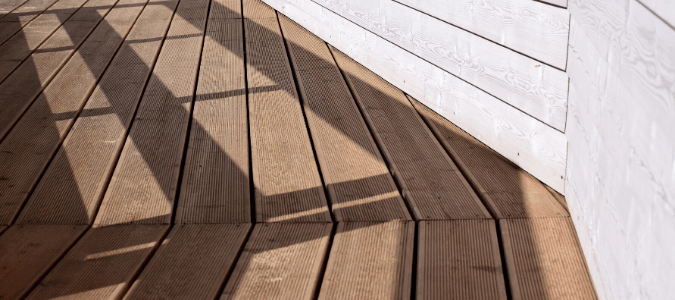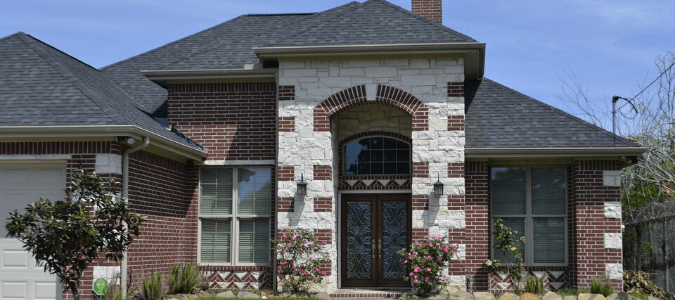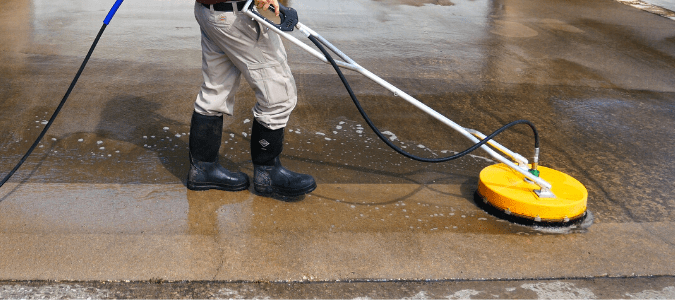
A deck provides you with additional space on your property for relaxing and gathering with friends and family. In many residential areas, these spaces get a lot of use. Unfortunately, dirt, pollen, dust and other grime can build up over time, which can detract from your deck’s appearance. Fortunately, there is a solution to this problem: power washing.
Power washing (also commonly referred to as pressure washing) is a great way to maintain your deck, as it is often the most effective way to make your deck look brand new again. Pressurized water is a powerful force, and it can even loosen up ground-in dirt that’s been there for quite some time. If you’ve never used a pressure washer before, however, you should know that you can damage certain surfaces and that there are risks and dangers associated with these machines. Once you learn how to power wash a deck, you can decide if you want to take on this task yourself or hire someone to do the job for you.
Chances are that you don’t already own a pressure washer. You can rent these from home improvement stores, although you’ll need a large enough vehicle to get this back to your home. If you want to try your hand at power washing, you may want to rent one of these machines the first time before you commit to this purchase. Typically, if you plan to power wash your deck or other surfaces three or more times each year, it makes more sense to buy instead of renting. Another option is to rent a larger piece of equipment if your surfaces haven’t been thoroughly cleaned for years and then purchase a less expensive model for touch-ups. If you do decide to purchase a pressure washer, you’ll need to make sure you have space to store it, and keep in mind you may need to invest in engine maintenance.
In addition to having a pressure washer, you’ll need to assemble all of your needed supplies if you plan to power wash your deck. Making sure you have all the tools you need from the start will give you a much better chance of having things go smoothly. Gather the following items near your deck area:
- Deck cleaner
- A broom
- Protective gear for ears and eyes
- A hose
- A stiff scrub brush
Now that you’ve gathered everything you need, it’s time to get started.
Power Washing a Deck: A Step-By-Step Guide
Power washing is incredibly effective, but there’s more to it than just pointing and spraying. In order to effectively power wash your deck, you need to prepare appropriately. Follow these steps to give your deck a refresh.
Safety First
Pressure washers can be extremely dangerous if you’re not careful. These machines can generate a spray of up to 3,000 pounds per square inch, or psi, and between 75 to 100 decibels of sound. In addition, some models heat up water so it’s hot enough to burn exposed skin. If you mishandle a pressure washer, at best you will damage your deck. At worst, you can seriously injure yourself. That’s why you need to wear appropriate attire when power washing. Safety goggles, thick pants, long sleeves, gloves, ear protection and boots are typically recommended. Additionally, you should avoid wearing loose-fitting clothing or jewelry, so nothing can get caught by the spray.
You should also read the pressure washer’s safety manual and follow all guidelines. For starters, understand how to turn off the pressure washer quickly, and make sure you turn it off whenever you’re not using it. Moreover, always pay attention to where you’re pointing the spray gun, so you don’t accidentally harm nearby plants, pets or people. Speaking of which, if you have small children or pets, you may want to have them indoors for their safety.
Lastly, make sure all of your windows and doors are firmly closed to avoid accidentally damaging any of your belongings inside of the home.
Clean and Sweep
Before you turn the pressure washer on, you want to clear the area you want to clean. Remove everything from your deck, including furniture, grills, rugs and plants. Power washing can break or damage fragile objects, and it won’t effectively clean underneath things. Move everything away from your deck to keep things simple and safe. Next, sweep the deck and get as much loose dirt and debris off as possible. Pressure washers are great, but it’s still wise to clear away any excess dirt or debris before getting started.
Apply the Deck Cleaner
Some deck owners choose to simply use water to clean a deck. If you decide to use a deck cleaning product, make sure to choose a product that is designed for your particular surface. Once you have the right type of cleaner on hand, look for a compartment in your power washer for cleaners and detergents. Follow the instructions for the power washer to fill the compartment with an appropriate amount of deck cleaner. Depending on the detergent, the amount can vary.
Next, attach the low-pressure detergent sprayer to the pressure washer. Deck cleaner should be sprayed gently and allowed to sit for a little while to loosen up stains and dirt. The cleaner may come with other instructions, too. For example, many deck cleaners recommend that you hose down plants in the area with clean water before you apply the cleaner. That keeps the cleaner from burning your plants and keeps your garden healthy.
You’ll probably want to use a scrub brush to get the cleaner into all the nooks and crannies. This includes the corners and between deck boards. Bad stains can also use some attention here. You can even use a specific rotating brush attachment to apply the cleaner to particularly bad stains. Then, let the whole deck soak for as long as specified for your particular deck cleaner. Don’t let the deck cleaner dry out, however, as this can lead to a streaky finish.
Spray Your Surfaces
After you’ve allowed the deck cleaner to sit, it’s time to power wash your deck. Find the widest sprayer attachment your pressure washer has and put it on. Let the washer get up to pressure, and then slowly and steadily start spraying. Long, slow passes from two feet away will help you get the most out of your wash. You can slowly begin to get closer to your surface, but try to stay 6 inches away to avoid any damage to your decking materials. Overlapping each pass will help as well.
To be on the safe side, you can start by power washing an area of the deck that is typically hidden or covered by outdoor furniture. While you can try using a narrower attachment, avoid using a zero-degree nozzle, as this concentrates spray and increases pressure in such a way that tends to pose unnecessary safety risks for both users and anyone nearby.
Depending on the size of your deck, the entire process can take anywhere from thirty minutes to a few hours. While it is extremely gratifying to guide the spray across these surfaces, power washing can also be quite tiring. And, you can end up getting wet and quite dirty. Don’t be surprised if the project takes up your entire day as you move on to other surfaces on your property, including your driveway, stone pathways and plastic lawn furniture. Yes, power washing can be extremely addictive!
Dry and Re-Stain
If you have a wood deck, you may choose to restain it after you have a freshly washed surface. If you do decide to stain your deck, let your surfaces dry for at least 48 hours before applying the stain. Wood absorbs water, even if it’s been stained. When that water is applied with intense pressure, it takes longer to fully dry out.
Once the deck has had a few days to fully dry out, you can decide whether you want to restain it. Many stains are fine after a power wash. However, if you have uneven spots, this is the perfect time to restain. Once that has dried, you can replace all your deck furniture and enjoy a clean, fresh deck.
Mistakes to Watch Out For
Beyond what we’ve already mentioned, there are a few other things to keep in mind.
Here are some additional power washing dos and don’ts:
- Practice extreme caution when spraying painted surfaces. Power washing tends to destroy these surfaces so you may want to test out an out of sight area before you try power washing a painted deck.
- Follow the power washer’s instructions for psi and distance when you’re spraying. Otherwise, you risk damaging your deck.
- Always power wash from top to bottom. Otherwise, the dirt from higher up will just run down over parts you’ve already cleaned.
- Always follow instructions for your particular brand of pressure washer and deck cleaner. There are differences between models and brands that can lead to subpar results and even damage if you don’t follow manufacturer and product recommendations.
If you’re not feeling confident in your abilities to power wash your deck without potentially damaging it, this is a service that a reputable handyman can do for you. You’ll also want to keep in mind, as we mentioned above, that decks aren’t the only thing that might need a thorough wash. Brick houses can start to look dull as dirt and plant matter becomes embedded in the bricks and a pressure wash can be the perfect way to brighten those surfaces.

How to Pressure Wash Brick House Walls
First, you should know that when you are talking about power washing versus pressure washing, these terms are generally interchangeable. Pressure washers are available for rent and purchase that can either use water straight from your outdoor spigot or that heat the water temperature to a temperature high enough to help clear away stubborn residue.
Here are the steps involved in pressure washing brick:
- Be safe. Just like with power washing, wear long pants, goggles, sturdy footwear and long sleeves. Also, never point the pressure washer at anything you don’t want to clean.
- Prepare the area. Repair cracks in bricks or mortar before you pressure wash. The force from a pressure washer can destroy cracked bricks and tear out crumbling mortar. You should also tightly seal windows, waterproof light fixtures, cover electrical outlets and place tarps over bushes and other landscaping near the home. Keep in mind that the older your home, the more likely it is that bricks are starting to crack. If your house is older, contact a professional to get your home pressure washed safely and without risking damage to your exterior and belongings.
- Apply detergent. Use the low-pressure detergent nozzle to spray detergent over the face of the house, if you’d like to use more than just water to clean off surfaces. Follow the product instructions to make sure you are allowing the ingredients to work as long as they need to for best results.
- Pressure wash your brick surfaces. Start from the top and work your way down with a wide sprayer nozzle. Spray in horizontal strokes over a 3 to 4-foot wide area at a time.
- Rinse and clean up. Hose down your driveway, sidewalks and anything else nearby to rinse away any dirty water that may have collected.
As with power washing, you don’t have to stop with your home’s exterior. There are other surfaces that can be pressure washed, but it’s important to know the correct psi for those surfaces so that you don’t risk damaging them.

What Is a Good PSI for a Pressure Washer?
Depending on the surface you want to clean, you need different amounts of pressure from your pressure washer. Choosing the right pounds per square inch of pressure (psi) will keep your possessions looking nice without damaging them. Here are some good rules of thumb:
- Wood, Plastic, Grills: A lower psi, such as between 1,300 and 1,900 psi, is usually adequate for these items, including plastic patio furniture, softer wood decks, grill components and lawn ornaments.
- Siding, Fences, Sidewalks: A medium amount of pressure—between 2,000 and 2,800 psi—is best for fences, lightly-soiled sidewalks and plastic siding.
- Bricks, Concrete, Stripping Paint: For more heavy-duty applications, psi levels from 3,000 to 4,000 are typically used. However, this is the level of pressure that can strip paint. You can also use these psi levels to clean bricks, deeply stained concrete or just about anything else. However, keep in mind that power washing can damage concrete if you aren’t careful, so try to stay at the low end of this range if you are power washing these surfaces.
Surfaces You Should Not Power Wash
You should avoid pressure washing older surfaces, soft surfaces or any items with electrical components. To be on the safe side, avoid pressure washing:
- Painted surfaces
- Roofing
- Wood siding
- Vehicles
If you are unsure of whether a surface would benefit from a pressure washing or power washing, your best option is to contact a professional. A company that offers this service will be able to advise you on the best cleaning method for the surface area you had in mind, and can pressure wash your property safely and efficiently without damaging any potentially delicate items.
ABC Can Leave Your Property Looking Brand New
Power washing your deck or another part of your property may seem like a pretty easy home improvement project at first, but when you consider the entire process, it becomes much more involved. You have to rent or purchase a pressure washer, and then you have to clear the area you’d like to power wash and then you actually have to do the hard work of getting the machine ready and all your materials assembled. And then you actually have to do the power washing! Then, you have to be careful to avoid damaging your home or injuring yourself or others. If this sounds like more than you bargained for, contact the pressure washing specialists at ABC Home & Commercial Services. We have the tools and expertise to pressure wash your home so you can sit back and enjoy your bright, refreshed surfaces.
